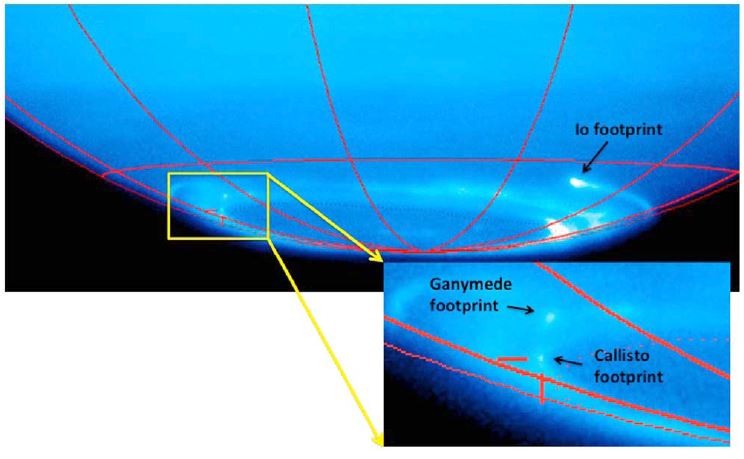20 February 2018
Found: “Footprint” of Jupiter’s moon Callisto
Posted by larryohanlon
By Larry O’Hanlon
The elusive “footprint” of Jupiter’s moon Callisto has been spotted for the first time near the south pole of the giant planet, according to a new study.
Such footprints – bright patches of ultraviolet light – are created by the four largest moons of Jupiter as the planet’s powerful magnetic field sweeps past them. The moons pluck the invisible magnetic field lines of Jupiter like strings on a guitar, sending high-energy electrons flowing along the field lines. These electrons light up small patches of Jupiter with ultraviolet aurora where the magnetic field lines enter the planet’s atmosphere.
Previous observations of Jupiter revealed the glowing footprints of the moons Io, Europa and Ganymede. But Callisto’s footprint has been harder to detect because the moon orbits further from Jupiter, which means it plucks magnetic field lines that enter Jupiter’s atmosphere at higher latitudes closer to the south pole of Jupiter. That’s right where the giant planet is already glowing brightly with ultraviolet southern lights, or aurora, caused by a cloud of highly-charged particles, or plasma, around Jupiter that come largely from Io.
In a new study in Journal of Geophysical Research: Space Physics, a publication of the American Geophysical Union, scientists report they have used a clever trick to detect Callisto’s footprint using a series of images from the Hubble Space Telescope (HST).
Not only does the discovery help scientists better understand the interaction of Jupiter and its moons, but it could help them understand the mostly unknown properties of the magnetic field further away from Jupiter, where Callisto orbits, and refine models of the giant planet’s magnetic field, according to Dolon Bhattacharyya, a planetary scientist at Boston University and lead author of the new study.

Jupiter’s south pole as seen in ultraviolet light by the Hubble Space Telescope on 24 May 2007. This image has been produced by adding together eight consecutive images observations of Jupiter’s south pole aurora. The candidate for Callisto’s footprint is shown by the red tick marks to the left. The other bright spot above Callisto’s footprint is Ganymede’s footprint which was close to Callisto’s orbital position on this day. Io’s footprint can be seen on the right.
Strumming the field lines
Jupiter’s magnetic field is generated by electrical currents in the planet’s rapidly spinning core, which is made of liquid metallic hydrogen. At the planet’s cloud tops the magnetic field is 10 times stronger than Earth’s.
Jupiter’s magnetic field rotates at the same speed as the planet, which is very fast – one rotation every 10 hours. Jupiter’s moons orbit the planet much more slowly, so the planet’s magnetic field lines are constantly sweeping past the moons. Those magnetic field lines interact with the moons, which are also bathing in the plasma cloud surrounding Jupiter.
In that environment, the moons act similar to iron rods in a magnetic field: They generate electrical currents. Those currents energize high-energy electrons present in Jupiter’s plasma environment, which then flow along the magnetic field lines and into Jupiter’s atmosphere, creating patches of aurora.
“They hit really fast because they have been energized,” Bhattacharyya said. “They hit sort of like a rocket entering Earth’s atmosphere. They start glowing.”
To find Callisto’s footprint in all that aurora light, Bhattacharyya and her colleagues first used a simplified model of Jupiter’s magnetic field to estimate where the footprint should be. Then they studied a series of HST ultraviolet images collected on May 24, 2007. They added the images together so that the fast-moving aurora ring of Jupiter rotating at the same speed as the planet became blurred, while the much slower footprint of Callisto tied to the orbital position of the moon, became brighter and more distinct.
As a result, Bhattacharyya and her colleagues found three bright spots: those of Callisto, Io and Ganymede.
“It’s really hard to detect” Bhattacharyya said of Callisto’s footprint. “You need a lot of images. We had a really large [HST] campaign in 2007, so we had a nice chunk of pictures we could test. This is probably the first time so many continuous images were available.”
— Larry O’Hanlon is an independent science writer and social media manager. He manages the AGU Blogosphere.










 GeoSpace is a blog on Earth and space science, managed by AGU’s Public Information staff. The blog features posts by AGU writers and guest contributors on all sorts of relevant science topics, but with a focus on new research and geo and space sciences-related stories that are currently in the news.
GeoSpace is a blog on Earth and space science, managed by AGU’s Public Information staff. The blog features posts by AGU writers and guest contributors on all sorts of relevant science topics, but with a focus on new research and geo and space sciences-related stories that are currently in the news.
….wowsers….. that is actually pretty cool… – in the event you can see a scene that i shall mention… there could be (is….) in the future an satellite or orbitting station not mucking with that system…, i mean cycle of the moon passing by then generating electricity upon the magnetic lines.. =- so a station (do not think sci fi design…, or neon flashing bits for vessels pulling in to the docking bays for batteries changeovers…. anyways…)… an conductor with the proficient and correct technology; the collecting of electrons – electricity – ions such as the Pearson – Anson effect oscillators.. anyways… – let us hope the astronaut food… has improved a little at that stage in the bipedal development awesomeness…